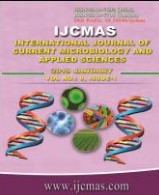


 National Academy of Agricultural Sciences (NAAS)
National Academy of Agricultural Sciences (NAAS)

|
PRINT ISSN : 2319-7692
Online ISSN : 2319-7706 Issues : 12 per year Publisher : Excellent Publishers Email : editorijcmas@gmail.com / submit@ijcmas.com Editor-in-chief: Dr.M.Prakash Index Copernicus ICV 2018: 95.39 NAAS RATING 2020: 5.38 |
Assessment of impact of temperature and CO2 on growth and yield of rice crop using DSSAT model has been made to assess the impact of these two parameters on the productivity of rice crop at south Gujarat region. For this purpose CERES-Rice model v4.6.1 was used in which the experimental result of rice during kharif, 2016 used as baseline to assess the rice yield under different climatic variability. Crop production is inherently to variability in climate. Temperature and CO2 are two important parameters related to climatic variability, which affect crop yield of a particular region However, on the basis of study carried out in the region, the model was run and rerun for temperature increase or decrease by 1 or 2 0C and CO2 concentration increase or decrease 100 or 200 ppm. The deviation in rice productivity from 2016 was estimated and analysed to assess the effect of temperature and CO2. Simulated rice yield revealed the reduction in yield by -3.25 to -9.47% at increase in maximum temperature at 1 or 2 0C, while decrease in maximum temperature at 1 or 2 0C yield increase up to 5.93%. If the minimum temperature in decreased at 1 or 2 0C the yield increase by +1.23 to 26.56%. while increased CO2 in the level of 100 and 200 ppm showed gradual yield increment about +5.84 to +7.11% and +9.95 to +13.73%, respectively.
 |
 |
 |
 |
 |